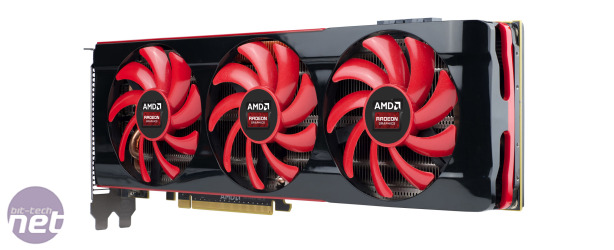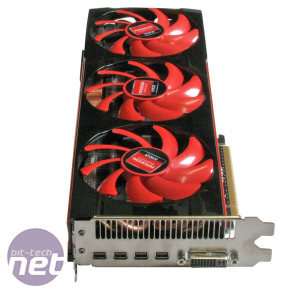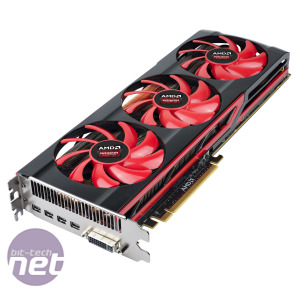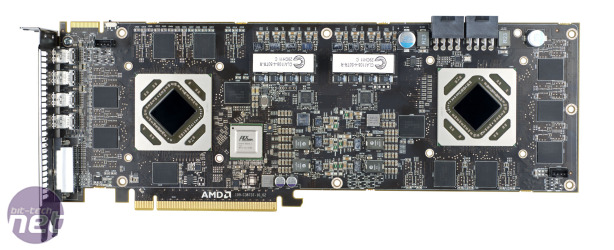
AMD Radeon HD 7990 6GB Review
Manufacturer: AMDUK Price (as reviewed): MSRP £860 (inc. VAT)
US Price (as reviewed): MSRP $999 (ex. Tax)
When AMD hinted that it would be focussing on adding new SKUs to its product line-up in 2013 rather than replacing its current South Islands GPU architecture, we strongly suspected the arrival of the long awaited dual-GPU HD 7990 was on the cards. In fact, a number of AMD’s partners couldn’t wait this long; in the past we’ve already looked at Club 3D’s triple slot 7990 and the Asus Ares 2, both of which featured a pair of AMD’s top-end Tahiti XT GPUs in CrossFire on a single PCB. While those humongous, exotic-cooler equipped cards might have been AMD’s illegitimate children (to the Night’s Watch with them!), today sees the legitimisation of the 7990 SKU with an official AMD PCB, cooler design and set clock speeds.
Click to enlarge - A pair of Tahiti XT GPUs on a single 12in long, dual slot card
The pair of GPUs at the heart of the 7990 are identical to that of the Tahiti XT GPU we first encountered way back in December 2011, although AMD has re-named the chips Malta for the multi-GPU SKU. This means they’re still built on the 28nm production process and South Islands architecture, with each offering the maximum of 2,048 stream processors. These are sub-divided between 32 compute units (AMD refers to them as GCNs), which are then further divided between four SIMD (single instruction, multiple data) engines of 16 stream processors each. Using the same GPU as the HD 7970 also means that each GPU boasts 32 ROPs and has access to a quartet of 64-bit memory controllers for a combined 2 x 384-bit memory interface with which to communicate with the 6GB of on-board (3GB per GPU) of GDDR5.
Put the two Malta GPUs together and you’re left with an 8.6 billion transistor 4,096 stream processor, pixel stomping beast, but AMD has made a couple of compromises to keep the heat (and power consumption) down. Whereas most HD 7970s now on sale will be the 1,050MHz core frequency GHz editions, the HD 7990’s GPUs run at 1GHz. The 7990’s 1.5GHz (6GHz effective) memory frequency matches that of the 7970 GHz Edition though, and means the card packs 2 x 288GB/sec of memory bandwidth (as with all multi-GPU cards, each GPU only has access to its own memory pool).
Click to enlarge - Beneath the shroud is a huge pair of heatsinks
While the specs aren’t too unsurprising, AMD’s ability to cram both GPUs, with a 1GHz core frequency, into a dual-slot card is seriously impressive. What’s more, it requires just a pair of 8-pin PCI-E power connectors to run. In comparison, the Club 3D 7990 we looked at in December ran at a core frequency of 925MHz, required three 8-pin power connectors and used an enormous triple-slot cooler. Asus’ Ares 2 didn’t compromise on frequency, running its pair of Tahiti XTs at 1,050MHz but also needed a trio of 8-pin power connectors, not to mention a dual-waterblock water cooler to keep temperatures under control.
Click to enlarge - The HD 7990 6GB boasts five mini DisplayPort connectors
The official HD 7990 is a much more subtle beast (if you can call a 12in/305mm card subtle) and finished in AMD’s red and black livery looks suitably smart. The card is dominated by a trio of 80mm down-draft fans that blow air down through an enormous 8-heatpipe equipped heatsink that covers almost the entire area of the PCB. Beneath the heatsink is a further ridged aluminium plate that covers power circuitry and memory modules, with a back-plate cooling the memory modules on the cards under-side. It’s all encased in a plastic shroud that’s perforated on all sides to allow hot air to be exhausted on all sides. This will mean a significant amount of the card’s 375W TDP of heat will be deposited into your case, so needless to say decent ventilation is key. The fact that AMD has crammed a pair of its biggest GPUs onto a single PCB, dual-slot card remains a highly impressive feat though, and the engineers behind it should feel suitably pleased with themselves.
In another change from the rest of the 7-series, AMD has chosen to fit the HD 7990 with five display outputs rather than the usual four. However, it’s dropped HDMI in favour of Dual Link-DVI and a quartet of mini-DisplayPort connectors.
Click to enlarge - AMD's PCB designers have excelled themselves by cramming everything onto a standard height, 12in PCB
While its specs and existence aren’t too surprising, the HD 7990’s price may catch some off guard. When we looked at Club 3D’s model last year it was selling for around £700, whilst a pair of HD 7970 GHz Editions will currently set you back around £660. In comparison, AMD has set an asking price of £860 for the HD 7990 6GB, seeing it topple even Nvidia’s GTX Titan as the current most expensive GPU on the market. This price does include AMD’s opulent Never Settle 8-game bundle, but a £200 premium for placing two GPUs onto a single PCB goes well beyond Nvidia’s pricing of the GTX 690 last year. Can the HD 7990 justify its price tag, and earn the big gold belt of Fastest Card In The World™? Let’s hit the benchmarks and find out.

MSI MPG Velox 100R Chassis Review
October 14 2021 | 15:04













Want to comment? Please log in.